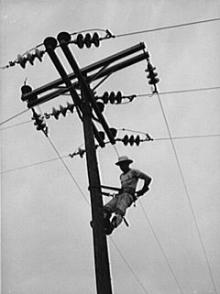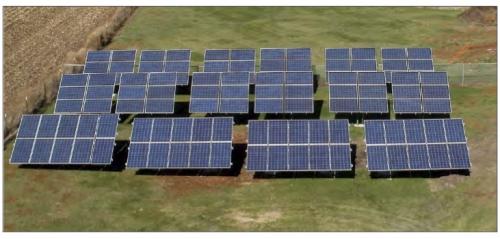Rural Electric Cooperatives and Renewables: The Future of Distributed Generation?
When we think about renewable energy, we often envision futuristic technology and progressive ideas. When we think about rural America, we might picture older traditions rooted in an agricultural lifestyle. And yet, we are increasingly finding some of the most exciting examples of renewable energy development far from busy metropolitan centers.
In particular, rural electric cooperatives, which provide power to sparsely populated areas of the country, are becoming increasingly involved in the politics of renewable energy and distributed generation (DG). Some stand in direct opposition to progressive energy policies or DG. Others, however, have begun to champion change.
What are Rural Electric Cooperatives?
Electric cooperatives are non-profit utilities that are established to provide at-cost electric services to their member-customers. Created by an Executive Order in 1935 under FDR’s New Deal, the Rural Electrification Administration (REA) brought electricity and prosperity to rural areas of the country that investor-owned utilities refused to serve because of cost concerns. The REA provided low-interest, long-term loans to entities that would construct electrical infrastructure for rural areas of the country. Farmers and other rural citizens formed cooperatives to take advantage of the loans. Now, electric cooperatives provide electricity to 12% of Americans, owning 42% of the country’s electric distribution line miles to accomplish that task.
There are two types of cooperatives: distribution cooperatives, and generation and transmission (G&T) cooperatives. Distribution cooperatives provide end-users with electricity, usually residences and businesses. Generation and transmission cooperatives are usually owned and managed by several distribution cooperatives to sell wholesale power to distribution cooperatives.
Electric cooperatives are owned by their customers, who each have one vote. A Board of Directors, which is elected from among the membership, governs the cooperative and hires a professional staff. The Board establishes the policies and procedures that are implemented by the cooperative’s management.
It is this one member, one vote democratic structure that engages cooperative membership and sets electric cooperatives apart from their investor-owned utility peers, who are controlled by shareholder interests. The democratic structure of electric cooperatives can enable cooperatives to make progressive changes to their energy policies, but only if their member-customers demand renewable energy.
Unfortunately, the vast majority of rural electric cooperatives are hostile towards renewables. The National Rural Electric Cooperative Association (NRECA), the national trade association that represents over 900 rural electric cooperatives to state and federal legislatures, has published its stance on several key renewable policies, including:
- Opposing feed-in tariffs, net metering, and distributed generation, based on the argument that these policies would result in significant cost increases for customers;
- Opposing mandates on power supply(renewable portfolio standards) on the grounds that they could undermine local board control of power supply decision-making, threaten system reliability, or unduly raise the cost of electricity for members; and
- Opposing using Clean Air Act regulations to regulate greenhouse gas emissions.
NRECA drafts white papers, maintains online organizing tools, and has a political action committee that it uses to spread these views, make political donations, and lobby legislative bodies in order to advance these policies. Though they are most focused on affordability and reliability, their policies simply maintain the status quo, and do not work to improve their members’ environment or promote local economic development via renewables.
Rural electric coops also often view state Renewable Portfolio Standards (RPS) as a threat to the affordability of electricity for their members, as well as an infringement on their independence. Currently 29 states have RPS laws in place, which also apply to cooperative utilities, though usually at lower standards. This fight is occurring in Colorado and other states, where rural electric coops are going head to head with government regulators and environmentalists over RPS deadlines that they feel are too ambitious.
Cooperatives can vary significantly on how they approach renewables, however. There is an emerging movement of cooperatives that see renewables as an opportunity to generate their own electricity, diversify their power supply, protect members from volatile prices, and create jobs in the communities of their members. Here at CPN we are getting an increasing number of requests from members of cooperatives asking: “How can we change our local Coop?”
Specifically, as renewable industries achieve economies of scale and installation prices plummet, rural electric coops are increasingly turning to renewable options for electricity and heat production. Distributed generation is inherently advantageous to rural communities, as it eliminates the excessive costs of connecting long electricity lines from current generation sites to individual rural communities, where the average number of customers per mile of line is less than one fifth that of investor-owned utilities in more densely populated areas. Renewable generation sites can even be located on, or in close proximity to, residential properties because they don’t produce pollution like coal-fired facilities. This also reduces the risk of outages due to severe weather disturbing long transmission lines, increasing rural self-reliance. The inherent advantages distributed generation presents to rural communities, combined with the more cohesive and engaged customer bases of electric cooperatives, could soon make rural electric cooperatives a major force in the demand for distributed renewable electricity generation.
There are several electric cooperatives across the country that have begun adopting renewable energy sources into their fuel mix. For example, Dairyland Power in Wisconsin has sourced 12.5% of its retail energy sales from wind, hydroelectric, landfill gas, animal waste, and solar, exceeding its RPS mandate by over 4%. Southern Maryland Electric Cooperative installed a 5.5 MW, wholly-owned solar farm. And in sunny Hawaii, Kaua’i Island Utility Cooperative has installed over 280 watts of solar per customer.
An Outstanding Example of a Rural Cooperative Embracing Renewables
 Among rural electric cooperatives that are leading the charge for renewables, Farmers Electric Cooperative (FEC) stands out. Located in rural Kalona, Iowa, FEC currently serves 640 subscribers/members. Located in one of the most conservative communities in the nation, it is also quite possibly the most progressive utility in America. The coop offers a number of incentives to encourage customers to develop renewable energy projects or implement energy efficiency measures, including a feed in tariff, energy efficiency incentives, remote real-time metering, and load controls. As of October 2013, FEC had over 20 customer-owned solar electric systems with a combined capacity of 260 kW, ranging in size from 2 kW to 50 kW. FEC also manages a 40 kW solar garden/community solar project that is fully subscribed. With 20% of the coop’s subscribers buying in to solar PV, the FEC has one of the highest participation rates for a green power program of any utility in America. They’ve also started constructing a 500 kW solar farm that, once completed, will place FEC as the national leader in installed solar with 1250 watts per member-customer.
Among rural electric cooperatives that are leading the charge for renewables, Farmers Electric Cooperative (FEC) stands out. Located in rural Kalona, Iowa, FEC currently serves 640 subscribers/members. Located in one of the most conservative communities in the nation, it is also quite possibly the most progressive utility in America. The coop offers a number of incentives to encourage customers to develop renewable energy projects or implement energy efficiency measures, including a feed in tariff, energy efficiency incentives, remote real-time metering, and load controls. As of October 2013, FEC had over 20 customer-owned solar electric systems with a combined capacity of 260 kW, ranging in size from 2 kW to 50 kW. FEC also manages a 40 kW solar garden/community solar project that is fully subscribed. With 20% of the coop’s subscribers buying in to solar PV, the FEC has one of the highest participation rates for a green power program of any utility in America. They’ve also started constructing a 500 kW solar farm that, once completed, will place FEC as the national leader in installed solar with 1250 watts per member-customer.
FEC’s policies are decided by a volunteer Board of Directors that is elected each year by the members. The cooperative’s activities are implemented by a general manager and staff. Though Warren Mckenna, the general manager, has driven many of the cooperative’s innovative programs and emphasis on renewable energy, he has declared that, “If it can be done here, it can be done anywhere.”
The following are a number of documents that outline the successes of FEC, details of their programs, and what Warren envisions for the future of coop:
- Maharishi University of Management Report on FEC – A detailed report of the FEC’s history and various programs. An excellent, detailed breakdown of how FEC has supported distributed generation.
- Warren McKenna Blog – A January 2013 25×25 guest blog written by Warren McKenna explaining why the FEC has pursued renewable projects, and relating his experience in Germany for his future plans for the FEC.
- 25×25 Germany Renewable Energy Study Tour – In September 2012, a group of rural and energy leaders ventured to Germany with the 25×25 organization for an educational tour of renewable energy facilities. This report details the tour, and provides information on the group’s findings and its recommendations for future actions by the 25×25 Distributed Energy Work Group.
- Iowa City Press Citizen Article – December 2012 local newspaper article about Warren McKenna and his work with the FEC.
- FEC Work – A brief discussion of the FEC staff and some of the work the cooperative has done in the past.
- NREL Press Release – A May 2011 press release from the National Renewable Energy Laboratory, recognizing the FEC for achieving the third highest customer participation rates in the country in its green power program. Also listed are other top performing utilities.
 Although FEC is leading the movement of progressive rural electric cooperatives, it would not be impossible for other cooperatives to adopt more progressive policies and support distributed generation among its member customers. All rural electric cooperatives are structured to operate democratically, with members serving on the Board of Directors and guiding the decisions of the organization. Communities could mount efforts to elect new, progressive members to cooperative Boards, or launch campaigns to expose the backwards policies of their existing cooperative Board. How communities go about changing their electric cooperative’s policy priorities may vary, but taking steps to get progressive Board members elected could be an excellent first step.
Although FEC is leading the movement of progressive rural electric cooperatives, it would not be impossible for other cooperatives to adopt more progressive policies and support distributed generation among its member customers. All rural electric cooperatives are structured to operate democratically, with members serving on the Board of Directors and guiding the decisions of the organization. Communities could mount efforts to elect new, progressive members to cooperative Boards, or launch campaigns to expose the backwards policies of their existing cooperative Board. How communities go about changing their electric cooperative’s policy priorities may vary, but taking steps to get progressive Board members elected could be an excellent first step.
Community Power Network offers tools and resources to help communities work for change. If you’d like help starting a petition, advocating for better policies for your rural electric cooperative, or help getting progressive members elected to your coop board, contact us!
